Goal Area 4: Identifying and Eliminating Commercial Tobacco and Nicotine-Related Disparities
Generations-long social, economic, and environmental disparities contribute to poor health outcomes. Breakdowns by race, ethnicity, socioeconomic status, or other demographic variables may reflect where a person lives, works, or plays rather than the individual’s characteristics or personal choices (CDC, 2022c). These disparities have a greater impact on health outcomes than individual choices. The pressures of discrimination, poverty, and other social conditions can increase commercial tobacco use and increase health problems.
Addressing these health disparities is the fourth goal of the SUTPP and the CDC to reduce commercial tobacco or nicotine use and the related health burdens among populations disproportionately impacted by commercial tobacco-related disease and death.
Starting in 2019, the SUTPP identified four populations of focus in Wyoming that were unequally impacted by commercial nicotine use: people with low incomes, people who self-identify as American Indian, people reporting behavioral health conditions, and young adults (aged 18-29). The sampling methods described in 2023 Adult Tobacco Survey Methods section included extra effort to recruit people identified as American Indian in the sampling frame WYSAC purchased.
For ENDS within each population, WYSAC analyzed three key indicators: the prevalence of use, ENDS quit attempts, and exposure to secondhand ENDS aerosol in public places.
For commercial tobacco within each population, WYSAC analyzed three key indicators: the prevalence of smoking cigarettes, smoking quit attempts, and exposure to secondhand smoke at work.
Because the Adult Tobacco Survey is primarily designed to obtain state-level data for the full adult population, WYSAC does not recruit people from these populations of focus in a way that allows for all analyses in the main body of the report or for intersectionality (such as estimates for young adults with low incomes). Specifically, because of the small number of Adult Tobacco Survey respondents who currently use commercial tobacco or nicotine products within each population of focus, there is a high degree of uncertainty around the estimates for most of these groups. Therefore, WYSAC took a cautious approach and chose not to provide interpretations for statistical tests in which WYSAC had a low degree of confidence, including when fewer than 50 adults responded to a question. Because of this issue, WYSAC does not report ENDS quit attempts among all populations of focus (including adults with low annual household income, American Indian adults, adults who reported behavioral health conditions, and young adults) or cigarette quit attempts among these populations except for adults with behavioral conditions.
Acknowledgement
Proportion plots in the following sections are adapted from a template distributed by Stephanie Evergreen: https://stephanieevergreen.com/proportion-plots/
Population of Focus: Adults with Low Annual Household Income
An ideal measure for identifying people with low incomes would be the poverty level. However, this varies by size of household and other factors not included in the Adult Tobacco Survey. Based on practical considerations such as survey sample size, WYSAC and the SUTPP used a threshold of $30,000 in annual household income to identify adults with a low annual household income.
For context, the median household income for Wyoming adults is $65,304 (U.S. Census Bureau, 2021). By definition, half of the adults in the state have an annual income less than the median.
ENDS and Adults with Low Annual Household Income
Evidence on ENDS marketing targeting people with low income is limited. Still, there is some indication that people with low socioeconomic status are more likely to see and be influenced by ENDS advertising (Addo Ntim et al., 2022). More research is needed to understand if the ENDS industry is using focused marketing toward people with low incomes.
ENDS Use
In 2023, 14% of adults with annual household incomes less than $30,000 used ENDS every day or some days. Among adults with an annual household income of $30,000 or more, 10% reported using ENDS every day or some days. Partly because the Adult Tobacco Survey did not sample a large number of adults with an annual income of less than $30,000, the difference in ENDS use was not significant.
Exposure to Secondhand Aerosol in Public Places
Partly because the Adult Tobacco Survey did not sample a large number of adults with an annual income of less than $30,000, the differences between reports of secondhand aerosol exposure in public places, indoors or outdoors, in the last seven days were not significant (Figure 28).

Cigarettes and Adults with Low Annual Household Income
Commercial tobacco industry marketing has a documented history of targeting lower-income neighborhoods (Lee et al., 2015). This targeted marketing has included giving free cigarettes to children in low-income neighborhoods. Along with the increased marketing, low-income neighborhoods typically have a higher commercial tobacco outlet density than higher-income neighborhoods (CDC, 2024c; Truth Initiative, 2018). With the commercial tobacco industry’s pointed strategies toward people with lower incomes, adults with lower incomes have a disproportionately high rate of commercial tobacco or nicotine use.
Cigarette Use
In 2023, adults with annual household incomes less than $30,000 were significantly more likely to smoke cigarettes every day or some days (24%) than those with higher incomes (10%; see Table 4 for a summary of the four smoking status categories).

Adults living in households making less than $30,000 per year were over-represented among adults who smoke.
While only 13% of survey respondents were living in households with an income of less than $30,000, they made up 27% of adults who currently smoke in the survey (Figure 29).
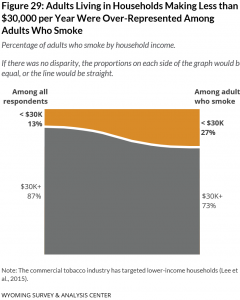
Exposure to Secondhand Smoke at Work
In 2023, 42% of adults with an annual household income less than $30,000 were exposed to someone else’s secondhand smoke at work. Adults with an annual income less than $30,000 were significantly more likely to be exposed to secondhand smoke at work than adults with an annual income of $30,000 or more (Figure 30).
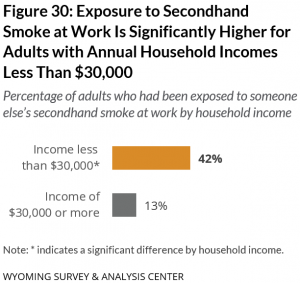
Occupational differences might explain this difference. For example, adults working in service industries are at a higher risk of exposure to secondhand smoke than those working in other industries (Holmes & Ling, 2017; Su et al., 2019), and they might have lower incomes. However, the 2023 Adult Tobacco Survey did not collect information about specific occupations.
Conclusion
The 2023 ATS data highlights the impact of the commercial tobacco industry’s targeted efforts to engage already vulnerable populations in commercial tobacco use (Lee et al., 2015). People with an annual income of less than $30,000 are disproportionately affected by smoking.
Partly due to the low sample size of adults with an annual income of less than $30,000, differences in ENDS use and exposure to secondhand ENDS aerosol in public places were not significant.
Adults with an annual income of less than $30,000 are significantly more likely to smoke every day or some days than those with an annual income greater than $30,000. Commercial tobacco is marketed at a higher rate in low-income neighborhoods (Lee et al., 2015).
At workplaces, adults with an annual income of less than $30,000 were also more likely to be exposed to secondhand smoke than those with a higher income. Without details about where Adult Tobacco Survey respondents work, we cannot explore reasons for this relationship.
Population of Focus: American Indians
WYSAC acknowledges that different terms, such as Native American, refer to the Indigenous populations of the U.S. when not referring to specific tribes. In this report, use of the term American Indian mirrors the CDC-suggested survey item (which does not ask about tribal affiliation) used for the Adult Tobacco Survey.
WYSAC considered respondents as American Indian when they self-identified as American Indian or multiracial including American Indian, regardless of whether they reported Hispanic ethnicity. This approach allowed for a larger sample from which to draw conclusions.
ENDS and American Indians
ENDS Use
In 2023, 33% of American Indian adults used ENDS every day or some days. American Indian adults (33%) were significantly more likely to use ENDS than non-American Indian adults (9%).
American Indian adults were over-represented among adults who use ENDS. While only 2% of survey respondents were American Indian, they made up 8% of adults who currently use ENDS in the survey (Figure 31).
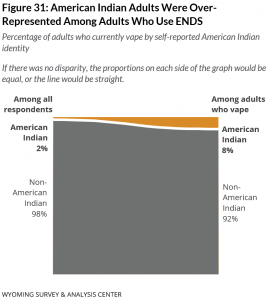
Exposure to ENDS Aerosol in Public Places
Partly because the Adult Tobacco Survey did not sample a large number of American Indian adults, the differences between reports of secondhand aerosol exposure in public places, indoors or outdoors, in the last seven days was not statistically significant, though the estimates may look quite different (Figure 32).
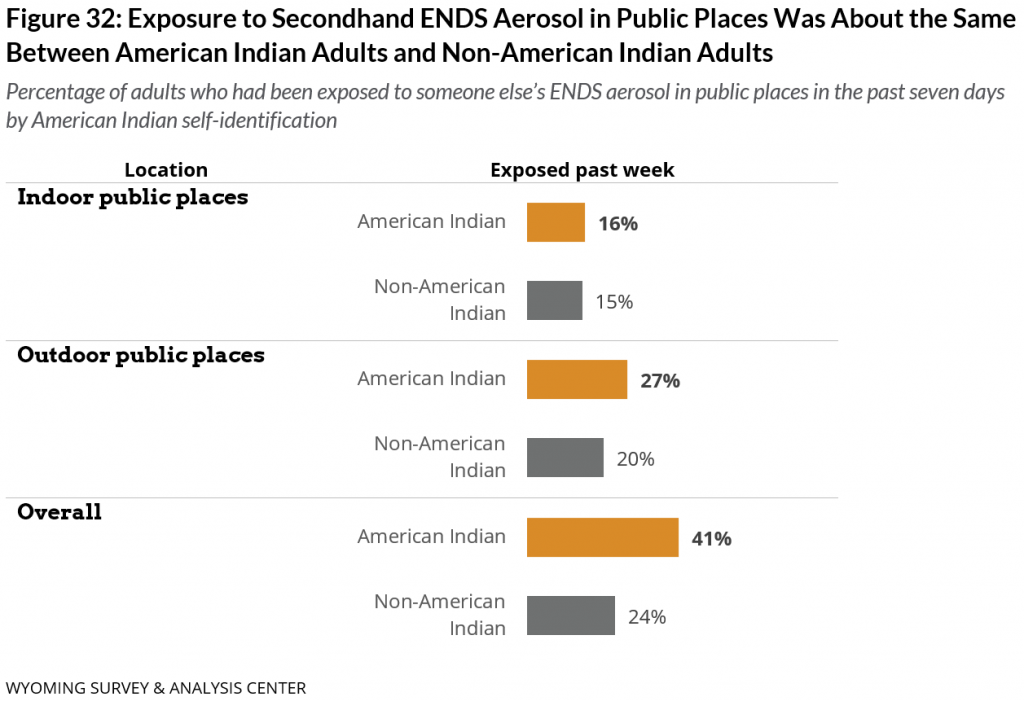
Cigarettes and American Indians
Commercial tobacco companies have long used the ceremonial significance of tobacco to encourage American Indians to use their commercial tobacco products (D’Silva et al., 2018). Commercial tobacco companies have a history of targeting this community, beginning with using American Indian imagery and symbols in marketing, often depicting negative stereotypes. The commercial tobacco industry misled these communities by providing financial support for their cultural events and providing highly discounted prices on commercial tobacco or nicotine products (Lempert & Glantz, 2019). The commercial tobacco industry’s focused efforts have contributed to disproportionately high smoking rates for American Indians (D’Silva et al., 2018).
Cigarette Use
In 2023, 19% of American Indian adults smoked cigarettes every day or some days. Among non-American Indian adults, 11% reported smoking every day or some days (see Table 5) for a summary of the four smoking status categories). Partly because the Adult Tobacco Survey did not sample a large number of American Indian adults, the difference in cigarette use between American Indian adults and non-American Indian adults was not significant.
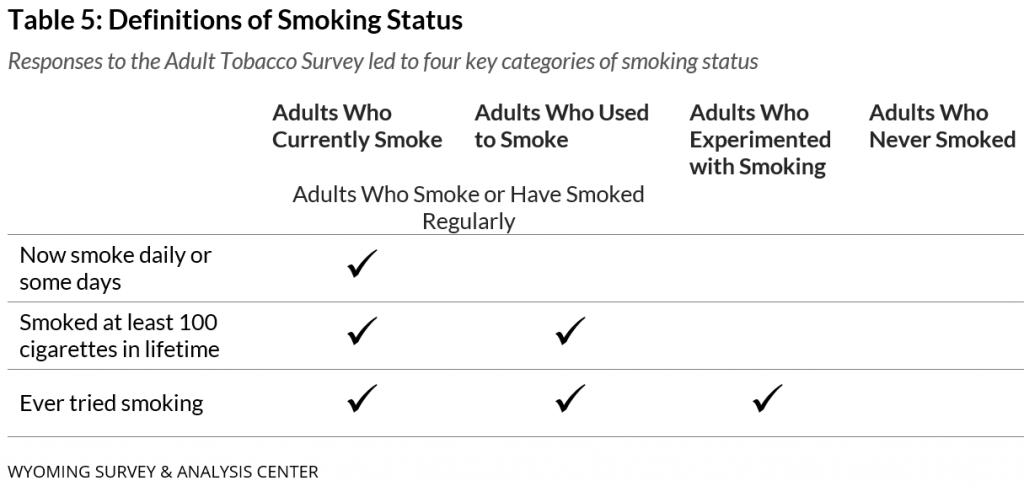
Exposure to Secondhand Smoke at Work
In 2023, 45% of American Indian adults were exposed to someone else’s secondhand smoke at work. American Indian adults were more likely to be exposed to secondhand smoke at work than non-American Indian adults (Figure 33).
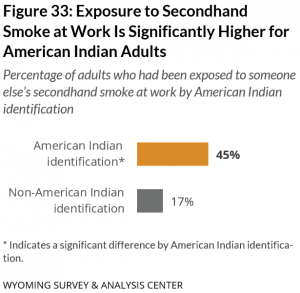
Conclusion
The 2023 Adult Tobacco Survey data highlighted the impact of the commercial tobacco industry’s targeted efforts to engage already vulnerable populations in commercial tobacco or nicotine use. American Indian adults are disproportionately affected by ENDS use, though the 2023 sample did not show disproportionate effects of cigarette smoking. American Indian adults were also more likely to report secondhand smoke exposure at work. Without details about where Adult Tobacco Survey respondents work, we cannot explore reasons for this relationship.
Continuing to partner with representatives from the two main tribes in Wyoming (Northern Arapaho and Eastern Shoshone) will support sensitive approaches to reducing the burdens of commercial nicotine use and secondhand exposure for this population.
Population of Focus: Behavioral Health
For this report, we use the term “behavioral health” and recognize that subject matter experts may use, and distinguish between, terms such as behavioral or mental health, and these may have changed over time. The CDC-suggested item is as follows: “Do you have any mental health conditions, such as an anxiety disorder, depression disorder, bipolar disorder, schizophrenia, attention-deficit/hyperactivity disorder (ADHD), post-traumatic stress disorder (PTSD) or substance use disorder?” About 25% of adults reported having at least one behavioral health condition.
People experiencing behavioral health conditions have been harmed by unjust practices related to the sale of commercial tobacco and nicotine. These practices include promoting the false idea that tobacco and nicotine can be used to treat behavioral or mental health conditions and promoting unhealthy policies in behavioral healthcare facilities (CDC, 2024d). These misperceptions may affect healthcare providers’ willingness to offer cessation treatments to adults with behavioral health conditions and increase smoking among people with behavioral health conditions (CDC, 2024b).
As with any self-report data, it is possible that people under-reported health conditions on the Adult Tobacco Survey, especially those conditions that may have stigma attached such as behavioral health conditions.
ENDS and Behavioral Health
Historically, the commercial tobacco industry has targeted people experiencing behavioral health conditions (such as depressive disorder, bipolar disorder, substance use disorder, and psychotic disorder; Campbell et al., 2016; Prochaska et al., 2017). The ENDS industry might also be targeting those experiencing behavioral health conditions by claiming benefits of using ENDS (Spears et al., 2019). For example, an online ENDS store claimed that “eCigs may help to cure depression” (ePuffer Inc., 2018). Medical research, however, has shown that vaping is associated with more reports of depression for adults (Obisesan et al., 2019) and youth (Lechner et al., 2017). More research is needed to understand if the ENDS industry is also using focused marketing toward people experiencing behavioral health conditions.
ENDS Use
In 2023, adults who said they had at least one behavioral health condition were significantly more likely to use ENDS every day or some days than adults who did not have at least one behavioral health condition: 27% of adults who reported having behavioral health conditions used ENDS every day or some days, compared to 5% of adults who did not report having behavioral health conditions.
Adults with behavioral health conditions were over-represented among adults who use ENDS. While only 25% of survey respondents said they had a behavioral health condition, they made up 64% of adults who currently use ENDS in the survey (Figure 34).
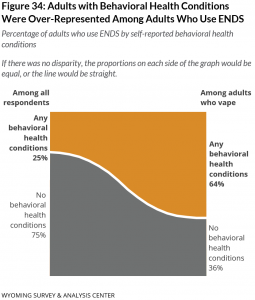
Exposure to Secondhand Aerosol in Public Places
In 2023, 30% of adults who reported having behavioral health conditions reported being exposed to someone else’s ENDS aerosol in public places, indoors or outdoors, in the past seven days. Overall, exposure to secondhand aerosol in public places was significantly more likely for adults who reported behavioral health conditions than those who did not report behavioral health conditions (Figure 35). In indoor public places, adults who reported behavioral health conditions (20%) were significantly more likely to report exposure to secondhand aerosol. The difference between secondhand aerosol exposure in outdoor public places was not statistically significantly different for adults with reported behavioral health conditions and those with no reported behavioral health conditions, though the estimates may look quite different.
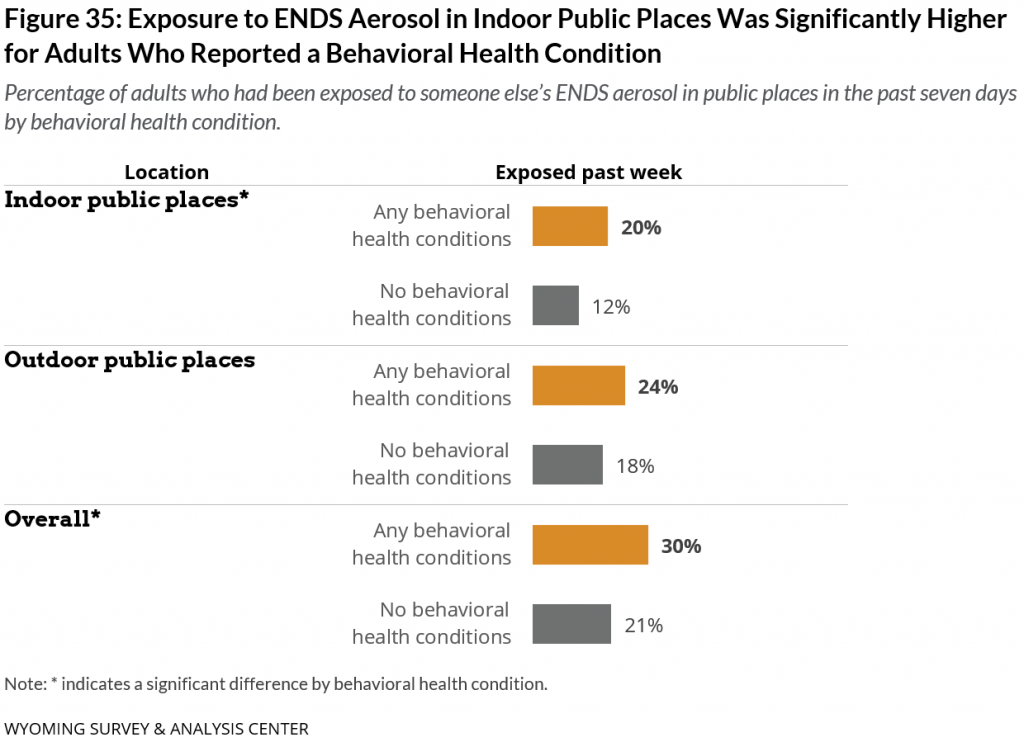
Exposure to secondhand aerosol from ENDS is particularly concerning for adults who reported behavioral health conditions as it may be a barrier to their efforts to quit. The specific impact of ENDS aerosol exposure on individuals with behavioral health conditions requires further research.
Cigarettes and Behavioral Health
Historically, the commercial tobacco industry has targeted people experiencing behavioral health conditions (such as depressive disorder, bipolar disorder, substance use disorder, and psychotic disorder; Campbell et al., 2016; Prochaska et al., 2017).
For this reason, studies (such as the Center for Behavioral Health Statistics and Quality, 2020, and Talati et al., 2016) have demonstrated an association between cigarette smoking and behavioral health conditions. People who report behavioral health conditions are more likely to smoke, and adults with these conditions who smoke tend to smoke more cigarettes than adults who do not report behavioral health conditions (Center for Behavioral Health Statistics and Quality, 2020).
Cigarette Use
In 2023, adults with behavioral health conditions (23%) were significantly more likely to smoke cigarettes than adults with no behavioral health conditions (7%).
Adults with behavioral health conditions were over-represented among adults who smoke while only 25% of adults who responded to the survey reported having behavioral health conditions, they made up 52% of adults in the survey who smoke (Figure 36; see Table 6 for a summary of the four smoking status categories).

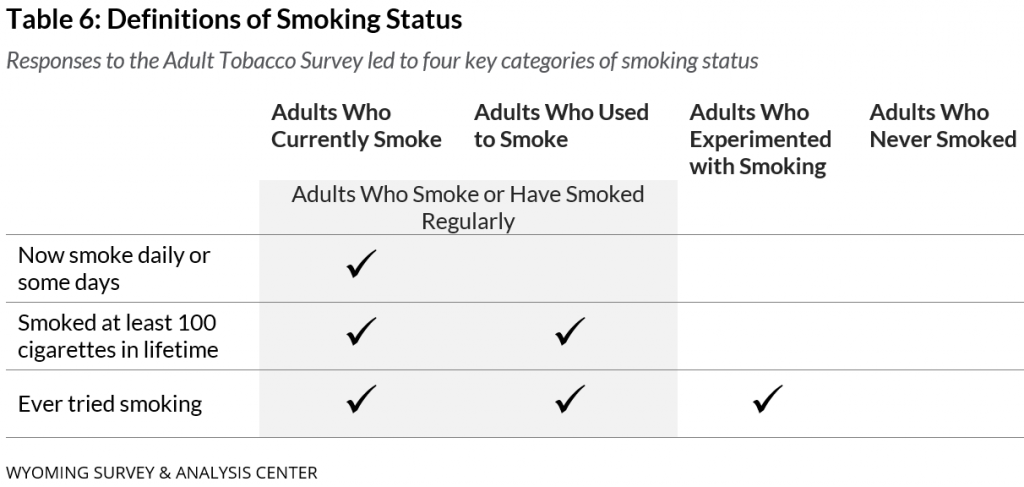
Quit Attempts: Lifetime and Past Year
Partly because the Adult Tobacco Survey did not sample a large number of adults with behavioral health conditions, the difference in quit attempts (including lifetime and past year) between adults who smoke and who reported behavioral health conditions and those who did not report such conditions was not statistically significant, though the estimates may look quite different.
Lifetime quit attempts:
- 88% of adults who reported behavioral health conditions had stopped smoking for at least one day because they were trying to quit for good, and
- 85% of adults who did not report behavioral health conditions had stopped smoking for at least one day because they were trying to quit for good.
Past year quit attempts:
- 61% of adults who reported behavioral health conditions had tried to quit smoking at least once in the past year, and
- 30% of adults who did not report behavioral health conditions had tried to quit smoking at least once in the past year.
Obstacles to Quitting Smoking Cigarettes
Adults who smoke and who reported behavioral health conditions were more likely to report obstacles to quitting than those who did not report such conditions, particularly in managing cravings and handling stress. In 2023, cravings for a cigarette (99%) and loss of a way to handle stress (95%) were significantly more common among adults with behavioral health conditions than those without behavioral health conditions (Table 7). Partly because the Adult Tobacco Survey did not sample a large number of adults who reported having behavioral health conditions, the differences in the other obstacles between adults who reported behavioral health conditions and those who did not report such conditions were not significant based on statistical testing. When working to reduce barriers to healthy behaviors, connecting people to evidence-based resources to address those barriers can be justified regardless of the results of statistical tests. The Wyoming Quit Tobacco (WQT) is an evidence-based program designed to address the common barriers that adults face when quitting smoking, including adults with behavioral health conditions.
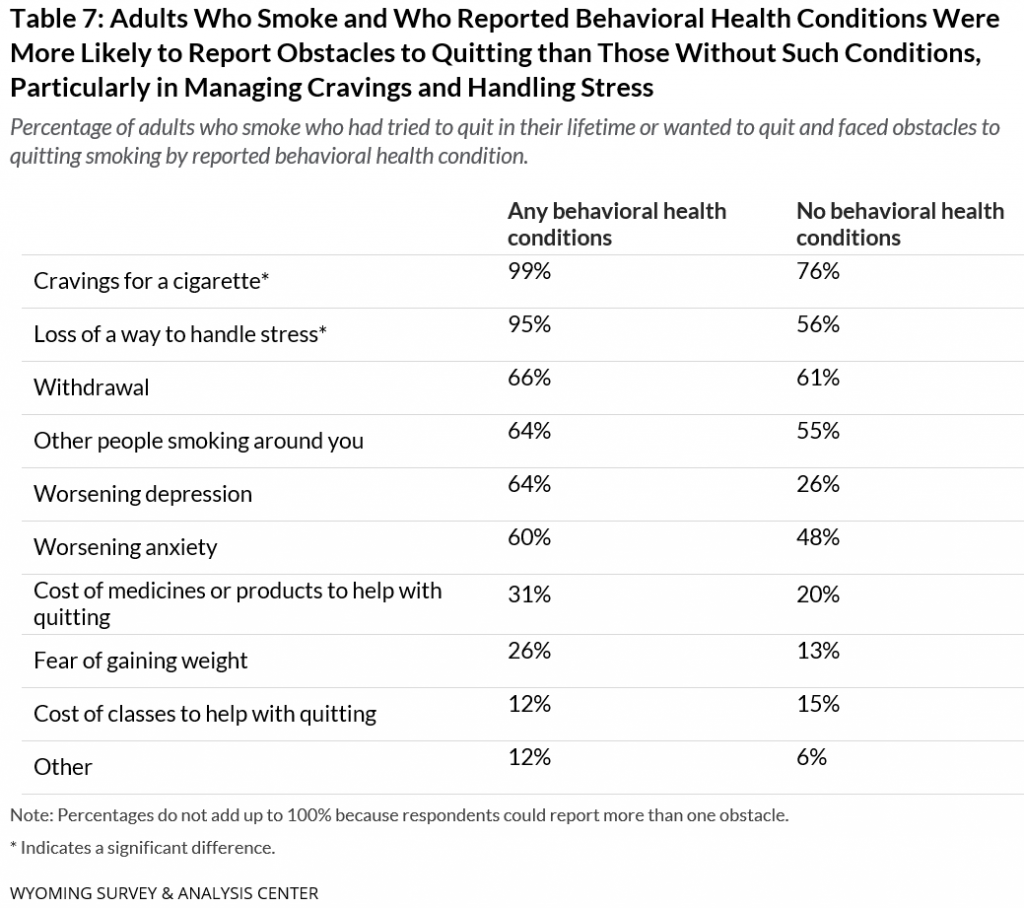
Exposure to Secondhand Smoke at Work
Adults who reported behavioral health conditions were more likely to be exposed to secondhand smoke at work (28%) than those who did not report such conditions (12%; Figure 37).
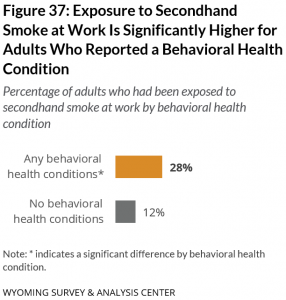
Conclusion
People experiencing behavioral health conditions are disproportionately affected by smoking and ENDS use. Particularly for cigarette smoking, this is likely related at least in part to the commercial tobacco industry’s targeted marketing (Campbell et al., 2016; Prochaska et al., 2017). More research is needed to understand if the ENDS industry is also using focused marketing toward people experiencing behavioral health conditions.
Adults who reported behavioral health conditions were more likely to use ENDS than those who did not report a behavioral health condition. They are also more often exposed to someone else’s ENDS aerosol in public places, particularly indoors.
Adults who report behavioral health conditions are more likely to smoke cigarettes than those who do not report such conditions. They are also more likely to be exposed to secondhand smoke at work than those who did not report such a condition. Without details about where Adult Tobacco Survey respondents work, we cannot explore reasons for this relationship.
In 2023, the Adult Tobacco Survey sampled too few adults who smoke and reported behavioral health conditions to detect a disparity in smoking quit attempts. Adults who smoke and reported behavioral health conditions were more likely to report obstacles to quitting smoking than those who did not report such conditions, particularly cravings for a cigarette and loss of a way to handle stress.
Population of Focus: Young Adults
WYSAC considered respondents as young adults when they were between the ages of 18 and 29.
ENDS and Young Adults
Young adults (aged 18-29) are a population of focus because young adulthood is an impressionable stage when people may begin a lifelong smoking or vaping habit (Biener & Albers, 2004; Lee et al., 2020). Additionally, nicotine use as the brain develops through the age of 25 (roughly) can change the brain to make it more vulnerable to additional addictions, cause difficulties in attention and thinking, and increase risk for behavioral health issues (USDHHS, 2016). Much like the commercial tobacco industry has targeted youth (Farber & Folan, 2017), the ENDS industry has targeted young adults with advertising and marketing that are attractive to them and has used social media as a pathway to reach young adults (Lee et al., 2020; Willis & Mindicino, 2020). The ENDS industry’s focused efforts have contributed to disproportionately higher ENDS use rates for young adults (Willett et al., 2019).
ENDS Use
Young adults (32%) were significantly more likely to use ENDS than other adults (5%). ENDS use may lead to later initiation of smoking, but more research is needed to investigate this potential pathway to smoking and, potentially, other commercial tobacco or nicotine products.
Young adults were over-represented among adults who used ENDS every day or some days. While only 20% of adults who responded to the survey reported being ages 18-29, they made up 61% of adults who currently used ENDS in the survey (Figure 38).
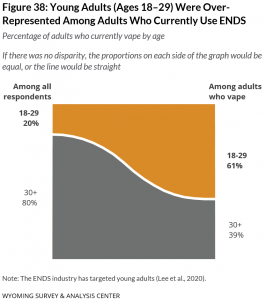
Exposure to ENDS Aerosol in Public Places
In 2023, young adults (40%) were nearly twice as likely to report being exposed to someone else’s ENDS aerosol in public places, indoors or outdoors, in the past seven days, compared to other adults (19%; Figure 39). In indoor public places, young adults (29%) were significantly more likely to report exposure to secondhand aerosol. Secondhand aerosol exposure in outdoor public places was also significantly higher among young adults (32%).
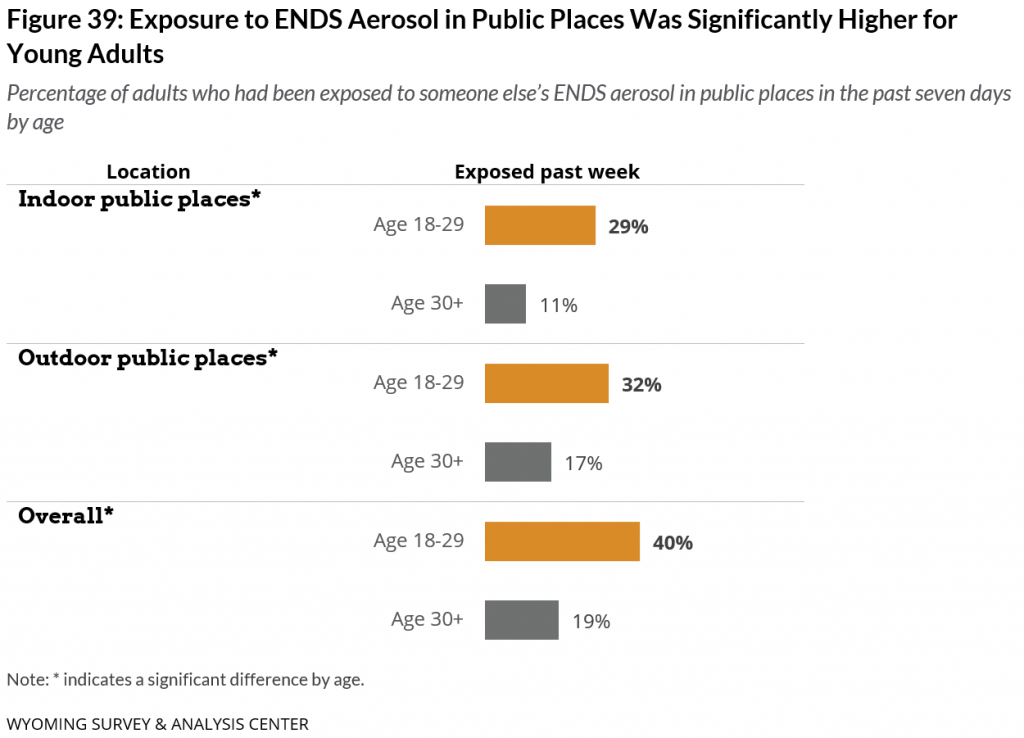
Cigarettes and Young Adults
Adult Tobacco Survey data (see Goal Area 1: Preventing Commercial Tobacco Use) show that most adults who smoke start smoking as youths or young adults. Young adulthood is an impressionable stage when people may begin a lifelong smoking habit, or a habit that had begun during adolescence could become set (Biener & Albers, 2004; Lee et al., 2020), making them a population of focus. The commercial tobacco industry has targeted young adults with advertising and marketing that promises to help them create the attractive, successful, and popular personas they seek (Farber & Folan, 2017). Industry campaigns promote messages, values, and product features designed specifically for young adults (Lee et al., 2020). Commercial tobacco companies place these campaigns in places young adults frequent most, such as colleges, fraternities, and bars (Ling & Glantz, 2002). With such targeted industry efforts, young adults are a population of focus and require equally targeted efforts for control strategies aimed at commercial tobacco and nicotine prevention.
Cigarette Use
The smoking rate of young adults (16%) was similar to the smoking rate of other adults (10%; Figure 40).

Young adults were more likely to have never tried a cigarette: 38% of young adults have never tried a cigarette, compared to 25% of other adults. Because so few adults begin smoking after the age of 21 (see the Goal Area 1: Preventing Commercial Tobacco Use section), this difference between age cohorts may indicate that experimentation with cigarettes is becoming less common over time.
Young adults were significantly less likely to have smoked regularly and then quit (11%), compared to other adults (31%).
As shown in the ENDS Use section above, young adults are more likely to use ENDS (32%), which may lead to later initiation of smoking cigarettes. More research is needed to investigate this potential pathway to smoking or the use of new and emerging commercial nicotine products (such as nicotine pouches). Research about potentially complex relationships between the use of various commercial tobacco and nicotine products is currently lacking.
Table 8 details the four categories of smoking status used in Figure 40.
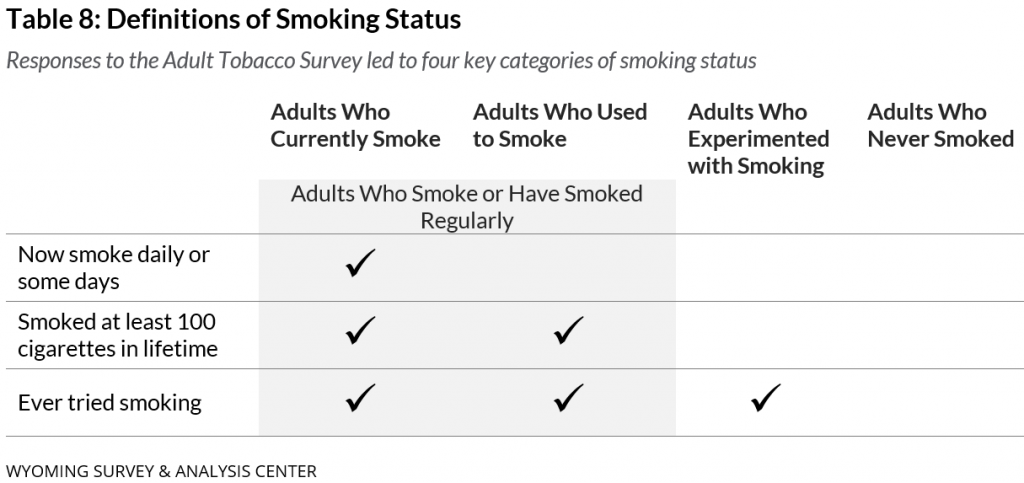
Exposure to Secondhand Smoke at Work
In 2023, 33% of young adults were exposed to someone else’s secondhand smoke at work. Young adults were more likely to be exposed to secondhand smoke at work than other working adults (Figure 41).
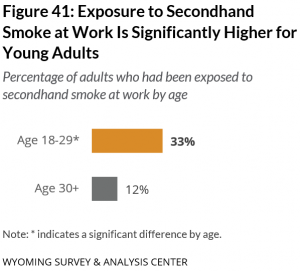
A possible explanation for this is an occupational disparity, as young adults who work in the service, maintenance, and transportation industries are at a higher risk of exposure to secondhand smoke than those working in other industries (Holmes & Ling, 2017). However, the 2023 Adult Tobacco Survey did not collect information about specific occupations.
Conclusion
The 2023 Adult Tobacco Survey data highlight the impact of the commercial tobacco industry’s targeted efforts to engage already vulnerable populations in commercial tobacco or nicotine use.
Young adults were significantly more likely to use ENDS than other adults (age 30 and older).
Young adults were significantly more likely than other adults to have been exposed to secondhand ENDS aerosols in public places or secondhand smoke at work in the last week. Without details about where Adult Tobacco Survey respondents work, we cannot explore the reasons for this relationship.
Young adults were more likely to have never tried a cigarette compared to other adults.

